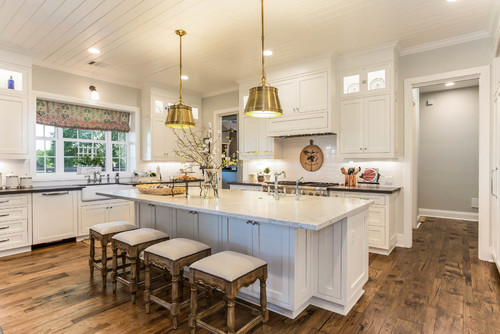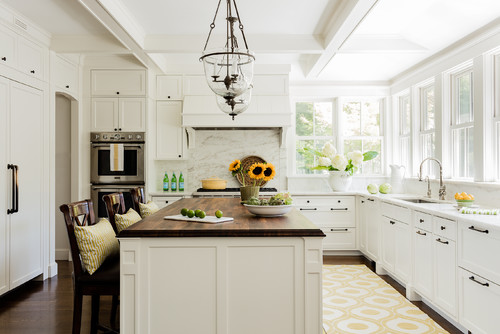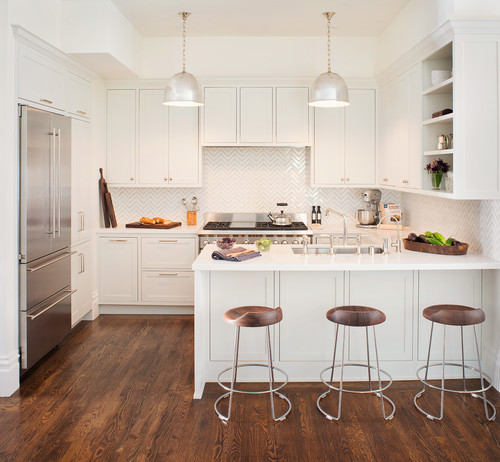Houzz Contributor, Veronica Solomon
An all-white room isn’t as simple as it may seem. If not done properly, the room can feel stark or boring. This is especially true when it comes to kitchens. There are so many hard surfaces in this space — countertops, flooring, appliances, cabinetry — that a white kitchen can end up feeling sterile.
But there are plenty of ways to use materials, light and texture to make the kitchen feel warm and inviting. Here are eight tips to help you plan the white kitchen of your dreams.
1. Layer Shades of White
Avoid a sterile look by mixing whites. If you use just one shade, the room can end up looking flat. Instead, choose three or four shades of white and place them on different materials around the kitchen. This will add dimension and interest throughout the space.
While you are bringing in different shades of white, avoid mixing warm whites with cool whites. Warm tones look more yellow, and cool tones look more blue. Most paint retailers will present their warm whites and cool whites separately, which will help you find whites in the same group.
My go-to warm whites are White Flour by Sherwin-Williams, White Dove by Benjamin Moore and Nude by Behr. For cool whites, I recommend White Diamond by Benjamin Moore, Designer White by Pratt & Lambert and Delicate White by PPG Pittsburgh Paints.
Why this white kitchen works: Three Benjamin Moore whites come together in this Texas kitchen. It has Titanium on the walls, Chantilly Lace on the ceiling, and Simply White on the trim and cabinets. The slightly different shades on each surface give the room dimension and add visual interest where the trio of paints meet, such as above the sink and doorways.
2. Use a Statement-Making Material
A well-designed white kitchen will depend on the finish materials used in the space. Materials like Carrara marble have strong visual appeal and instantly make a statement, even in a white-on-white environment.
As a general rule, limit materials with a lot of movement (such as the flowing patterns in marble) to just one element, usually the backsplash or countertop. Choosing subtler materials for other surfaces allows the statement-maker to shine.
Why this white kitchen works: The natural marble slab instantly draws your attention in this kitchen because the other materials and fixtures are more subdued. This lets the island, and its marble veins, be the star.
3. Bring On Texture
Bringing in materials with various textures — both tactile and visual— adds depth to a predominantly white kitchen. This can be done by mixing shiny with matte and rough with smooth for a dynamic look.
Why this white kitchen works: These textured pendant lights make a strong visual statement against the white cabinets while balancing the wood flooring. A kitchen that could have otherwise looked stark now feels warm and welcoming.
4. Add Accent Colors
Splashes of color in a white kitchen help play up the cabinetry. Choose a small number of contrasting colors — one, two or maybe three. Then repeat them in accessories to pull the theme together. Places to try adding a bit of color include seating, lighting, countertop canisters, rugs, backsplashes and hardware.
Why this white kitchen works: This kitchen injects bright colors into the seating, lighting and a memo board on the wall. Together, these colors give the room a friendly vibe while keeping the kitchen feeling white and bright. And they draw the eye from one part of the room to another, so you can enjoy every corner.
5. Take Advantage of Natural Light
Natural light from a window or skylight is a great benefit for any kitchen, but especially for a white kitchen because it bolsters the bright and airy feel you were going for in the first place.
Why this white kitchen works: The large set of windows above the sink lets ample light filter in throughout the day. The light is amplified by glass fronts on the upper cabinets. This feature takes advantage of all that light, reflecting it around the space and into adjacent rooms.
Tip: Window treatments in adjoining rooms can make a difference too. Consider using shades that can be pulled up completely in the daytime. This will allow even more natural light to filter into your kitchen.
6. Provide Softness
Fabrics bring pattern and softness into a white kitchen. Window treatments are an easy way to do this. You can also bring in fabrics through floor runners or other smaller rugs, or choose bar stools covered in fabric or leather instead of wood.
Why this white kitchen works: Roman shades with a subtle geometric pattern definitely help soften this kitchen. They are tailored and clean, and can be pulled up to maximize natural light entering the kitchen.
7. Top the Island
Let the kitchen island stand apart from the rest of your work surfaces by topping it with a different color or material. This bit of contrast also breaks up the room and provides your eyes with a nice resting place.
Why this white kitchen works: The wooden countertop on the island creates a center point in the room that feels as if it belongs because it echoes the floor material with its top and the cabinetry color with its base.
8. Bring Texture to the Backsplash
A white backsplash can be a great focal point, even if it’s all white. You can create this interest by using a pattern or textured material, such as mosaic stone, a three-dimensional tile, painted brick or a herringbone pattern.
Because the backsplash is one of the first things you see as you walk into a kitchen, and because it is such a small area, don’t be afraid to go bold with your pattern or textured pick.
Why this white kitchen works: Marble tiles in a herringbone pattern give life to the backsplash, which stretches from one wall all the way to the kitchen’s peninsula. These tiles, with their hints of gray and off-white, bring out the pattern without overwhelming.
Related Reads
Warm Up White With Statement Pendant Lighting
Make a Focal Point With Wooden Countertops
Have Fun With a Mosaic Tile Backsplash














